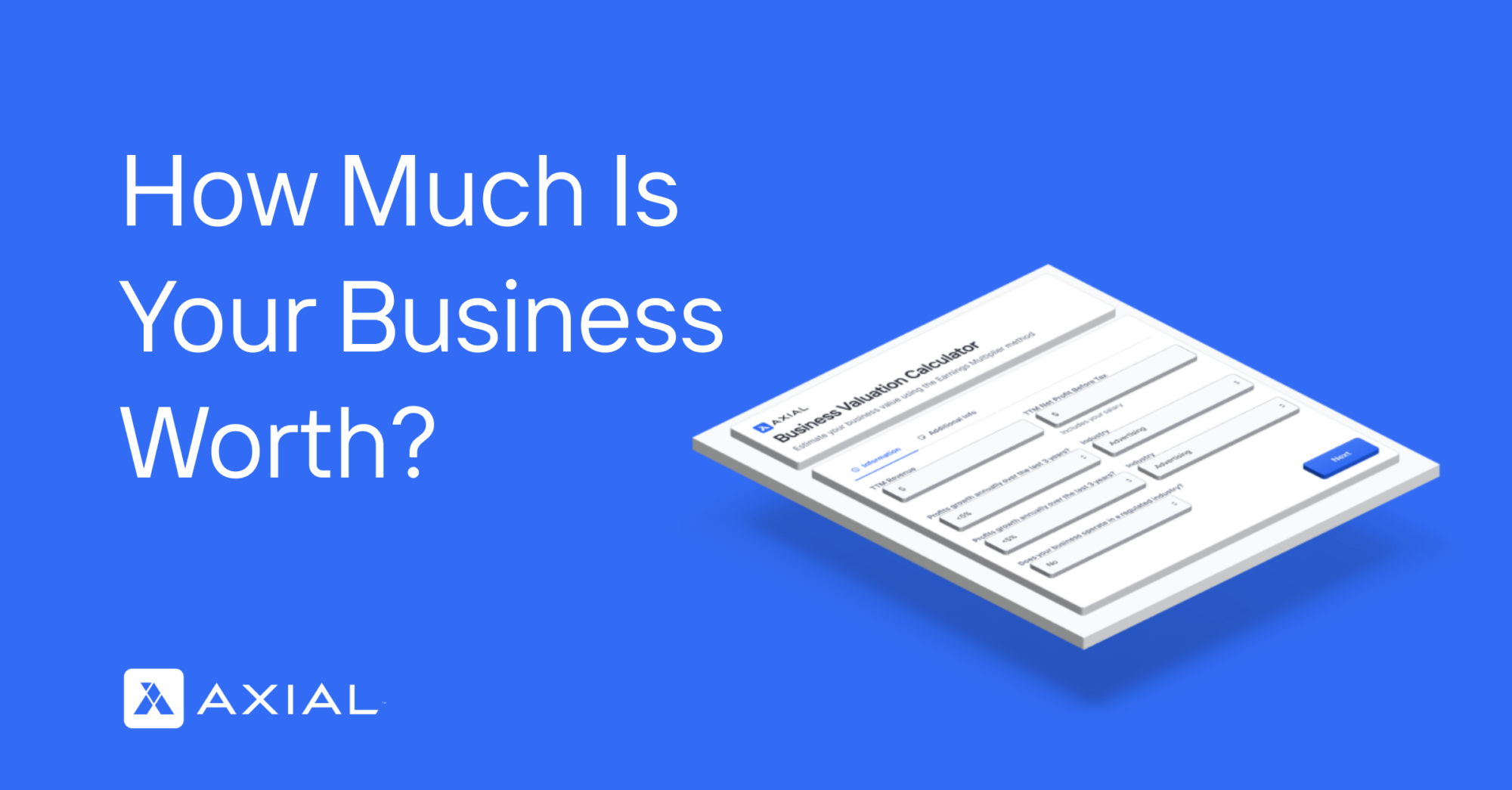
Introducing Axial’s Business Valuation Calculator – Find Out How Much Your Business Is Worth
The number one question our exit consultants hear from business owners is: “How much is my business worth?” To help…
Tags
There are several types of exit strategies for small businesses, each requiring careful planning. Options include initial public offerings (IPO), management buyouts, and last-resort measures like bankruptcy or liquidation.
In this post, we focus on developing an exit strategy to sell your business through the mergers and acquisitions (M&A) process. This approach aims to maximize value and negotiate terms that align with your personal and financial goals.
In this post, we cover:
When we surveyed investment bankers about common reasons business sales fall through, they listed a lack of formal exit planning as a major factor. This makes sense, as during exit planning, you’re defining what an ideal exit looks like to you and preparing your business for that exit.
As part of your exit planning, you will:
Understanding your motivations to sell will help you:
Common reasons for selling a business include retirement, personal health issues, significant life changes (such as a divorce or moving to a different state), outgrowing your business, and experiencing burnout. What they all have in common is a strong underlying motivation to sell, and that’s key.
You don’t want to be casual in your commitment to sell for two reasons:
For more information on deciding if it’s time to sell, check out our post on When to Sell Your Business. We discuss both internal motivations and specific market conditions that may signal it’s a good time to sell.
By understanding your motivations to sell, you can determine if now is the right time to work toward selling your business and develop an ideal buyer profile.
A buyer profile is a summary of the type of buyer you should target during the M&A process.
To determine your ideal buyer profile, you need to know:
Think of buyer profiles as existing on a spectrum. On one side, there are financial buyers, and on the other, strategic buyers.
Strategic buyers acquire a business to grow their own. They often pay a premium price, but your business may cease to exist, which can affect your legacy and your team. For example, a competitor might be interested in your business if you have intellectual property (IP) they want to own, or they may want to add your product offering to their catalog. They’ll buy your business to get what they need but may cut parts of the business they can’t use.
Financial buyers generally focus on how much they can increase the long-term value of the business they’re buying. This makes them a good option if you want a fair price for your business but also care about its legacy and the future of its employees post-sale.
Again, think of it as a spectrum. The key thing to understand is what you want for your business (its legacy and its team) and for yourself personally after the sale.
If you want the maximum sale price — perhaps to finance your retirement or another venture — and don’t mind your business being absorbed to get that price, then you’ll look for buyers closer to the strategic end of the spectrum. If you want your business to continue after you, and are concerned with brand and personal legacy, then you will look for buyers closer to the financial end of the spectrum.
To learn more about buyer profiles, read our post on: How to find a buyer for your business, where we explore different types of buyers in more detail and how to attract them.
Selling a business isn’t just a financial transaction; it’s a life-changing event that impacts those close to you, especially your family members. Start by having open discussions with those who will be most affected by this change. Ensure everyone understands the timeline and what to expect both logistically and financially.
Talk with your family about potential adjustments to daily routines and roles, such as how much more free time you may have once you’re no longer running the business. Address any concerns about how their individual careers may shift following the sale. Acknowledge the emotional aspects of this transition, as doing so can help everyone feel more at ease throughout the process.
Preparing your business for exit involves streamlining your operations, cleaning up financials, and implementing a transition or handover plan that addresses any key man dependencies.
Completing these tasks will not only increase the perceived value of your business but will also make it easier to address questions during the due diligence process.
1. Streamline your operations
Conduct a thorough assessment of your business processes, identifying both strengths and areas for improvement. Look for opportunities to cut costs (such as switching suppliers) and boost efficiency.
Streamlining operations is essential for increasing business value. You can learn more in our guide, 5 Ways to Maximize Business Value, where we discuss strategies for reducing costs, increasing revenue, and targeting the right buyers.
2. Clean up your financials and other key documents
Resolve any outstanding tax issues and ensure your financial statements are accurate and adhere to standard accounting practices. Confirm that any legal obligations, such as leases, contracts, intellectual property agreements, and supplier agreements are settled and well-documented.
3. Establish a handover plan to solve for key man dependencies
You want to make yourself redundant as the business owner. For example, if you’re a business owner who is managing customer/client relationships, then you need to transition yourself out of that role and move another member of your team into that role or create a system or process that helps your company maintain those relationships without you.
Without this, a buyer may perceive too much risk regarding the potential loss of customers after the sale, especially if those relationships are tied solely to you.
There are clear benefits to working with an M&A advisor to help you navigate the M&A process.
By leveraging their expertise in selling businesses like yours, an M&A advisor can determine an accurate business valuation, create targeted marketing materials, negotiate sale terms, and structure and close the deal. (More detail on the M&A process below.)
Most business owners struggle to find the right M&A advisor. They may rely on recommendations from other owners, which could lead them to a generalist with little experience in their specific industry. Alternatively, they may spend time researching advisors online without knowing how to properly vet and interview them, limiting their options.
At Axial, we connect you with M&A advisors who have relevant deal experience in your industry, helping you narrow down your choices to the best fit.
Our network includes over 2,000 M&A advisors.
When you connect with us, we’ll introduce you to an Exit Consultant who will learn about your business and create a curated list of 3–5 advisors. These advisors are evaluated according to their recent deal experience, down funnel success, and professionalism. They’ll also provide materials to help you interview the advisors on your shortlist, enabling you to build the right deal team and turn your exit strategy into a reality.
To determine if an advisor is the right fit for your business, it’s crucial to conduct thorough interviews before making your decision. This will help you weigh the pros and cons of each advisor on your shortlist. Your Axial Exit Consultant is available to guide you, and we also offer several resources to support you during this process, including:
Your exit strategy helps prepare you for the M&A process, which includes finding a buyer, negotiating sale terms, and closing the deal. All the steps we’ve discussed so far lead to this point, and understanding what to expect will help you see your exit strategy through to completion.
As part of the M&A process, you and your advisor will:
While the specific valuation methods may change based on your business, an advisor will generally conduct three analyses to triangulate an accurate valuation range:
These methods take into account valuation factors such as CapEx, the size of your business, historical financial stability, customer contracts, and more.
It’s key to work with an advisor experienced in selling businesses like yours to get an accurate valuation, as they can use data from past deals to refine their estimate. You can learn more about this in our post on how to value a company for sale, where we explore the three valuation methods in detail and cover common mistakes to avoid.
This includes an investment teaser with an anonymized business overview and a more detailed CIM (Confidential Information Memorandum) for interested buyers who sign an NDA.
In both documents, advisors highlight the attractive features driving current value and potential future opportunities your company could offer.
Screen Buyer Interest and Executing a Letter of Intent (LOI)
One major time-waster for business owners looking to sell is dealing with buyers who aren’t truly interested in making a competitive offer. M&A advisors work on your behalf to screen out “tire kickers” — buyers who pretend to be interested but will ultimately waste your time.
A typical week for an M&A advisor in screening and evaluating buyers might look like this:
When the advisor brings a deal to your attention that you want to pursue, they’ll help you execute a LOI. The LOI outlines the proposed price and deal structure for buying your business, but it’s not a purchase agreement.
By executing an LOI, you enter into an exclusivity agreement for a set period, usually around 90 days. During this time, you agree not to engage other buyers, allowing this buyer to conduct a full due diligence process on your company.
The next stage, if the process continues beyond an LOI, is final negotiations and closing the deal.
Advisors play a crucial role in negotiations, as they remain neutral and composed, often helping secure the most favorable terms. They know when to push for more, when to stand firm, and when to compromise, ensuring the best possible outcome.
As you go through negotiations, it’s important to remember the motivations for selling that you outlined in step one of your small business exit strategy. The final sale price is not just a number; it also reflects what you want to leave behind and what’s needed to fund the next stage of your personal life, whether it’s a new investment, retirement, or securing your children’s education.
During negotiations, you work with the buyer to align on the terms of the sale. This includes, but is not limited to:
Your advisor will guide you through the final decision-making process and help you structure the deal to meet your post-exit goals.
For example, a buyer might offer a smaller upfront cash payout or a larger payout spread over several years, contingent on meeting performance milestones. An experienced advisor can help you objectively evaluate these offers, leveraging their knowledge of your business and the market to determine the best deal structure for you.
Exit planning and strategy are complex topics for small business owners, and it pays to learn as much as possible about your options and the types of exit available as you prepare to sell your business.
Reflect on your goals and find the resources you need to build the best exit strategy for your company in Axial’s Exit Planning Center.
Further reading:
